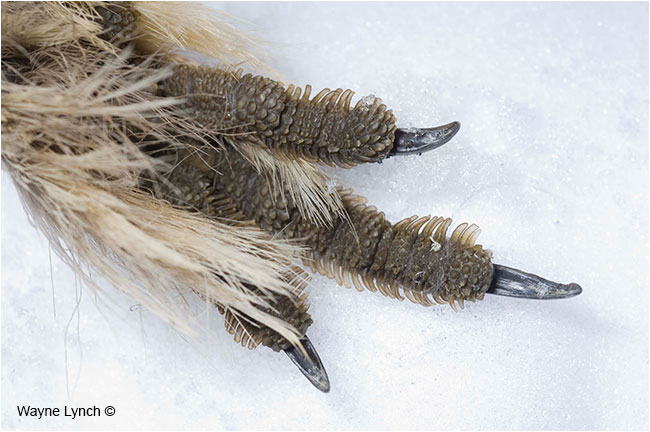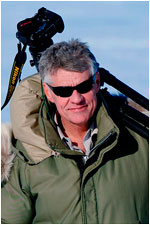
Art from the Afterlife
by Dr. Wayne Lynch
January 4, 2015
Ring Necked Pheasant closeup
After reading Rob Berdan’s recent article on road kills I started to reflect on how the death of wild creatures has often inspired me as a photographer. Understand that it always saddens me to see an animal that has been killed in a highway collision. Every day, around 190 million vehicles sputter and spew along the highways of North America. By some estimates, nearly 300 million wild creatures are killed on highways every year. That’s nearly a million road kills every day. As much as I decry this senseless waste of life, I discovered a long time ago that the victims could sometimes yield interesting photographs that were impossible to duplicate in the wild with live animals. Right about now you’re probably thinking that this photographer from Calgary is a real sicko. He cruises the highways scooping up carcasses and immortalizing the innocent victims with the sensor on his camera. Nonetheless, I have often found artistic satisfaction from photographing the biological details and haunting beauty that still exists in wild creatures after their death.
Dragonfly from SUV Grill
The beauty of necrography (a psychiatrist friend told me I should be proud to have coined the word) is that your subjects never bite, and they never run away - perfect subjects for the macro enthusiast. Instead of boring you with yet another discussion on the techniques of macro photography I thought I would tell you a couple of my favourite dead critter tales which might tempt you to capitalize on carrion.
Pinkies in a Pouch - Virginia Opossum Babies in Pouch
My wife and I made many enjoyable winter trips to Florida shooting stock photographs. One morning, on a daily drive to the post office, we spotted a dead Virginia opossum in the ditch. The animal’s body was still warm and she had six tiny newborns tethered to the nipples inside the pouch on her belly. I called Aubrey over for a closer look. The first thought that went through her mind was "What kind of creepy crawlies lurk in the opossum's scruffy fur that could abandon ship for a new hot-blooded host?" I had a different thought. Ignoring the leering gaze of nosey passers-by, I took the dead opossum back to our house. With a twisted coat-hanger, I propped open the mouth of the animal’s pouch and photographed the pinkies inside. On that fateful day in Florida I discovered that there are riches to be reaped from road kills. In the years since then, we’ve sold the newborn opossum shots dozens of times and earned thousands of dollars with them. In fact, we've never sold another photo from that trip to Florida, but we learned a valuable lesson. Road kills rule.
Spruce Grouse Pectinations
Ptarmigan Footage
One spring I flew to the High Arctic in early April to photograph frosted muskoxen in a snowy landscape. After we got back into town I got talking about ptarmigan with my Inuvialuit companions. Actually, the conversation revolved around ptarmigan feet and the dense feathers that grow on their toes in winter and function like snowshoes. It was a shot I had always wanted but I could never get close enough. Moments later one of the guys pulled out an unplucked frozen ptarmigan from his freezer. "I think this bird will let you get really close", he chuckled. For the next half hour, the guys watched me photograph the frozen feathery feet. Neither of them had any interest in photography but they loved to joke and laugh, and the story of the kabloona (Inuktitut for pasty-faced white guy) from Calgary who flew 3000 miles to photograph the feet of a dead ptarmigan is still one of their favourites.
Willow Ptarmigan foot
Talon Closeup of Road-killed Snowy Owl

American Beaver Closeup Road-killed Venomous Cottonmouth
When it comes to dead stuff I’m definitely fixated on feet. So many mammals and birds have feet that are biologically unique and fun to photograph. Over the years I’ve shot the digging claws of badgers and skunks, the roughened soles of tree-climbing porcupines, the grooming claws of beavers and herons, the pectinated toes of winter grouse, the splayed hooves of caribou, and the guano-soiled feet of turkey vultures to name just a few. I have so many shots like this that I published a children’s wildlife book in 1999 entitled “Whose Feet Are These?”, and won an award with it. Are you sceptics interested in dead stuff yet?
The Profitable Pocket Gopher
A few years ago I spent three months photographing the entire nesting cycle of a family of great horned owls. At one point in the project I found a dead pocket gopher on the ground beneath the nest. Perhaps the male parent had dropped the animal or a chick had accidentally knocked it out of the nest? I wanted the owl chicks to have their gopher, but climbing to a great horned owl nest with large chicks in it would be a challenge no parent owl could possibly ignore. They would surely attack me but I wanted to take the risk for the baby owls’ sake. So, wearing a hockey helmet and thick leather jacket I quickly climbed the nest tree and slam-dunked the dead rodent beside the chicks. The mother swooped menacingly close, but never touched me with her talons. Moments after I returned to the ground she was perched above the chicks glaring at the dead pocket gopher. In her tiny birdbrain she must have been thinking “Where did that big juicy rodent come from?” Minutes later, a happy ending. Dinner was served. I thought to myself, gopher it.

American Coot Clawed Foot Porcupine Foot

Red-Winged Blackbird Wing Plumage Muskox Hoof Closeup
A day before my altruistic (not to mention courageous) gesture I first borrowed the gopher for a photo shoot. Pocket gophers are hard to photograph in the wild, make that impossible to photograph, because these burrowing rodents rarely surface during the daytime. As soon as I found the animal I realized the photographic potential. After a night in the refrigerator, the groomed pocket gopher was ready for his modelling debut. I located a field where there were mounds of loose soil excavated by other pocket gophers, dug a hole in one of the mounds, and buried my friend with only his head and front legs visible as he might appear during a rare moment on the surface. In the golden glow of late afternoon, the animal's whiskers glistened in the setting sun. Ah, dollars from deception and dead stuff.
Common Barn Owl Plumage
Western Rattlesnake (Crotalus oreganus) Tail Rattle.
Art from the AfterlifeAlthough most of the photographs I take of the dearly departed are strictly biological, you can also create images that are artistic and evocative such as the feather patterns on birds, the texture of scales on lizards and snakes, and the multi-coloured designs on insect wings. Virtually all of the subjects for such photographs I scavenge from roadsides, and sometimes even pluck from the grill of my SUV. However, in my many years of such shooting. I’ve never become insensitive to the tragedy of death of any wild creature, and for me photography is a way to immortalize the beauty of their life after it has faded. So stifle your squeamishness, drag out your photo gear and go find something dead. There are imaginative images to create.
Western Diamondback Rattlesnake
WARNING: Before you start scavenging road kills from our highways, make sure you know the wildlife regulations in the province or state where you live. In many areas, possession of certain species of wildlife, even road-killed critters, requires a special permit that you must obtain from your local Fish & Wildlife office. Without the permit, you may be charged and fined for illegal possession of wildlife.
Bio: Dr. Lynch is a popular guest lecturer and an award-winning science writer. His books cover a wide range of subjects, including: the biology and behaviour of owls, penguins and northern bears; arctic, boreal and grassland ecology; and the lives of prairie birds and mountain wildlife. He is a fellow of the internationally recognized Explorers Club - a select group of scientists, eminent explorers and distinguished persons, noteworthy for their contributions to world knowledge and exploration. He is also an elected Fellow of the prestigious Arctic Institute of North America.
Dr. Wayne Lynch
3779 Springbank Drive S. W.
Calgary, AB, T3H J5
E-mail: lynchandlang@shaw.ca
Website: www.waynelynch.ca
Read other Articles on the Canadian Nature Photographer by Dr. Wayne Lynch
1. The Blind Photographer by Dr. Wayne Lynch
2. Manatee Madness by Dr. Wayne Lynch
3. Going After Gators by Dr. Wayne Lynch
4. Oomingmak - The Bearded One -by Dr. Wayne Lynch
[ Top ]













